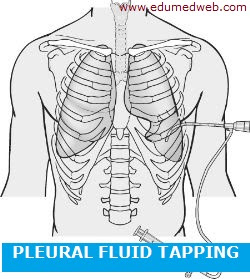Pleural Fluid Tapping
Pleural Fluid Tapping
Indications of Pleural fluid tapping
|
Diagnostic
|
Therapeutic
|
|
Physical, biochemical, cytological and bacteriological study of pleural fluid
|
Respiratory distress
|
|
Massive collection
|
Contraindications
|
Contraindications
|
|
1.Coagulation disorder
|
|
2.Platelet abnormality
|
|
3.Severe cough
|

Procedure
|
Step-Wise Procedure
|
|
|
1.The total procedure is explained to the patient to make him /her comfortable and relaxed.
|
|
|
2.The patient sitting and leaning forward position with arms folded before him/her and kept over a cardiac table.
|
|
|
3.The site of aspiration may be
|
6th Intercostal space in the Midaxillary line
|
|
7th Intercostal Space In The Posterior Axillary Line
|
|
|
8th Intercostal Space In The Scapular Line
|
|
|
4.The local part is prepared under strict aseptic condition.
|
|
|
5.The site of aspiration is infiltrated from the skin up to parietal pleura through subcutaneous tissue with 2 % lignocaine solution.
|
|
|
6.The pleural aspiration needle is inserted right angle to the skin, just above the upper border of the lower rib (to avoid injury to vessels and nerves).
|
|
|
7.The needle is then attached to a three-way cannula, and the cannula is in turn connected to a 50 mL syringe.
|
|
|
8.Application of suction in the syringe draws pleural fluid into the syringe which is pushed into a kidney-tray via the outlet of the three-way cannula by adjusting its screw.
|
|
|
9.Fluid should be aspirated slowly and much as possible until it is harmful to the patient. (generally not more than 1 litre on the first occasion)
|
|
|
10.The puncture site is sealed with tincture benzoin when the paracentesis is over.
|
|
|
11.The patient should be monitored for next 24-48 hours for development of any complication.
|
|
Complications
|
Complications
|
|
1.Pleural shock (as a result of vagal inhibition)
|
|
2.Empyema thoracis
|
|
3.Hydropneumothorax
|
|
4.Acute pulmonary oedema (if the fluid is aspirated very rapidly)
|
|
5.Air embolism
|
|
6.Injury to intercostal vessels and nerves
|
|
7.Haemothorax
|
|
8.Subcutaneous emphysema
|
|
9.Cardio-respiratory embarrassment with circulatory collapse
|
|
Thank you Reader
|
|
Your Like Motivate Us To Post New And Unique Articles So Don’t Forget To Like, Comment and Share This Post. LIKE US On Our Facebook Page To Get Latest Updates.
|
|
Copyright © 2017 by edumedweb.com
|
|
All rights reserved. No part of this post/article may be reproduced, distributed, or transmitted in any form or by any means, including copying, photography, Screenshot or other electronic or mechanical methods, without the prior written permission of the Admin. Otherwise strict legal action taken against that person.
For permission requests, write to the Admin
|
